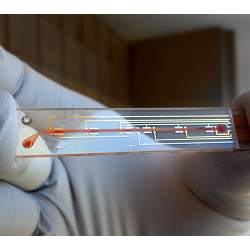
Researchers at Stanford University have created an 'always on' drug delivery system that ensures a patient receives the precise dosage of a medication 24 hours a day, seven days a week.
Still at the prototype stage, the researchers are looking to miniaturize the system so it can be embedded in the human body and continuously modulate the delivery of a medication.
"Our technology would be most beneficial for patients taking drugs that are powerful, but have harmful side-effects if given at too high of a dose," says Peter L. Mage, a Stanford post-doctoral researcher working on the project led by Stanford professor H. Tom Soh.
Children with cancer would especially benefit from a commercialized version of the device, given that the correct dosage amounts for those receiving chemotherapy can vary significantly by patient, Mage says.
The in-body sensor for the device is a molecule or aptamer specially designed to bind to the drug the device is programmed to monitor. As the concentration of the drug increases in the bloodstream, the aptamer changes shape; the greater the concentration of the drug in the bloodstream, the more the aptamer changes shape.
To regulate the amount of a drug in one's bloodstream, the researchers choose a baseline shape for the aptamer, and then program the system's software to add more drug to the bloodstream until the ideal shape change for the aptamer has been realized. The aptamer begins to change shape as soon as the drug is introduced into the bloodstream; when it reaches its ideal form (signifying the exact concentration of the drug needed), drug flow to the bloodstream ceases. When the aptamer begins to lose its ideal form, signifying that the body is metabolizing some of the drug, more is introduced into the bloodstream.
A miniaturized version of the tech would be extremely useful to medical first responders in emergency situations, since they often are desperate to use drugs to save the life of a patient, but may have no idea about the patient's medical history, allergies to certain drugs, the concentration of other drugs in the patient's system, and other vital information.
The sensing apparatus could also come in handy for doctors wanting to monitor the bloodstream for telltale signs of illnesses long before those ailments become a chronic threat to a patient. "Our sensor technology can be adapted to measure not only other drugs, but also protein biomarkers and metabolites that could serve as health indicators," Mage says.
"The development of long-term implantable sensors that could provide continuous health monitoring through measurement of a variety of biomarkers is a major area of ongoing research for our group and others around the world," he adds.
So far, the research team has been very successful testing the prototype device in animals, and is eager to replicate those results in humans. Specifically, the team was able to maintain drug dosages at an optimal level in a number of different species, despite the fact that the metabolisms of those animals varied widely.
Moreover, the researchers were also able to retain the optimal dosage for a drug even after releasing a second drug into the test, a condition that can radically skew the efficacy of the original drug if not modulated properly.
"We used MATLAB running on a standard Windows PC to control both the sensor hardware used for drug measurements and the drug infusion pump," Mage says. Overall system design, as well as fine-tuning of its modulation, was accomplished with Simulink, he says.
Sang-Hyun Oh, a professor in the Department of Electrical and Computer Engineering at the University of Minnesota, describes the team's work as "a tour de force in biomedical sensing. Developing a biosensor device that can detect target molecules reliably in the bloodstream is an extremely challenging task in itself.
"The seamless integration of molecular recognition, electronic sensor technology, and control systems engineering is an important step forward toward developing sensors for human patients."
Mage sees the always-on drug delivery tech initially popping up in full-sized form for use with the standard-sized drug infusion pumps and catheters already used in hospitals today.
In the longer term, he sees great promise for the system's miniaturization, given that a research group led by Robert Farra (CEO of Switzerland-based CeQur, a medical device firm "dedicated to helping people with type 2 diabetes manage their disease") has already developed a miniaturized drug delivery pump that can be implanted in the human body.
Also encouraging for the system's commercialization are related research successes in miniaturization, including the work of a team lead by Kevin Plaxco, a professor and director of the Center for Bioengineering at the University of California, Santa Barbara (UCSB). "We have developed smaller probes that can be implanted into rodents, indicating the miniaturization will not be a significant challenge," says Tod Kippin, a researcher on Plaxco's team and a professor at UCSB's Institute of Collaborative Biotechnology.
The cost of the parts for the full-sized system is $4,000. Mage is unsure how much a miniaturized version of the prototype device would cost, but he's encouraged that many of what would be its core components are already used in inexpensive medical devices currently on the market. "The electronics required for electrochemical drug measurement are similar to those required for the subcutaneous glucose sensors already used in continuous glucose meters, which are a widely available, well-developed, and miniaturized commercial technology," Mage says.
In addition, he says, "the drug sensors in the system are disposable and inexpensive—less than $10 each to manufacture—while the other hardware is presently comprised of off-the-shelf components that would cost similarly to the digital infusion pumps currently used in hospitals."
Joe Dysart is an Internet speaker and business consultant based in Manhattan.



Join the Discussion (0)
Become a Member or Sign In to Post a Comment